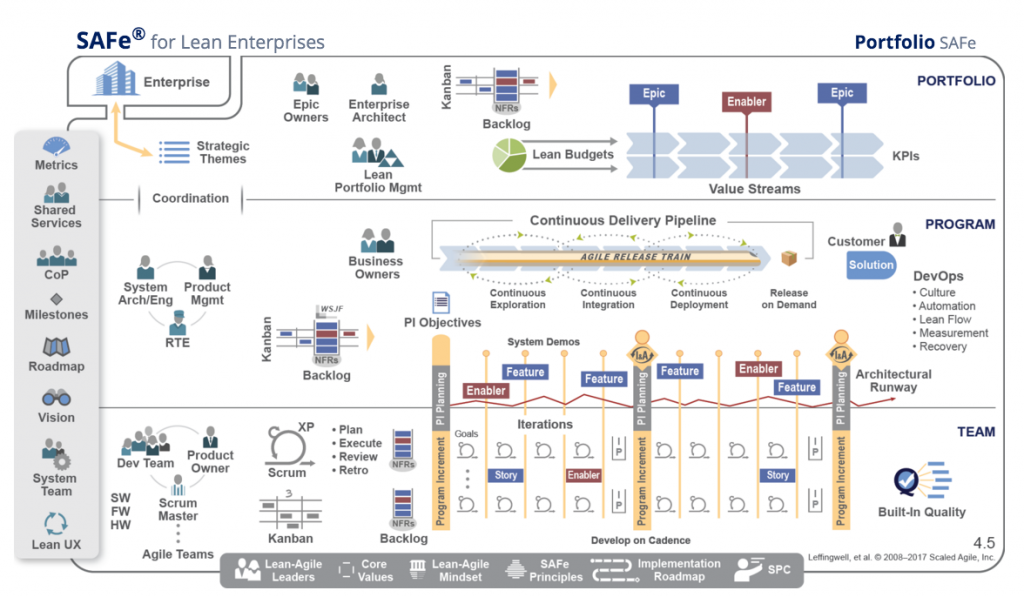What is the Scaled Agile Framework (SAFe)?
The Scaled Agile Framework, referred to as SAFe, is intended to be a version of Agile that works for large, enterprise organizations, that have multiple teams, dependencies, and controls that must be orchestrated and balanced against Agile values.
SAFe has 3 layers of abstraction: Team, Program, and Portfolio. The Product Manager is specifically at the Program level whereas the Product Owner is a role at the team level. Product Mgmt at the Program level evaluates market need and opportunity and determines appropriate features to achieve the portfolio-level strategy. The Product Owner by comparison, is the more tactical role, defining specific requirements/user stories for those features, representing those to the Scrum team, and taking care of traditional Scrum Product Owner responsibilities such as Sprint planning and backlog grooming.

While Agile is known for being nimble with the ability to have frequent iterations, SAFe, can be more cumbersome and takes on some similarities to the waterfall approach with a top-down approach – it is an example of “ Wagile”, a very common adaptation of principles from both Waterfall and Agile processes.
The Scaled Agile Framework, SAFe, was introduced in 2011 by Dean Leffingwell as the “Agile Enterprise Big Picture” with the publication of his book Agile Software Requirements. The goal of creating this method was to scale up Agile for enterprises without sacrificing the value of effective requirements discovery and analysis. Since then, SAFe has become a common standard within larger enterprise organizations.
Features vs Capabilities
An interesting nuance about SAFe for Product Managers is that it smartly distinguishes two types of projects – Features and Enablers. A Feature is user-facing and is described by a Product Manager. A capability is more often an internal platform solution that a product sits on top of and takes advantage of, which is defined by the technical team. For example, a technical team might create software that stores all account information across the enterprise. Requirements for Enablers are often driven by the Program Architect which is a peer to the Product Manager at the Program level. The Product Manager meanwhile might then build a My Account feature on the customer-facing website or mobile app, that utilizes this capability, which “enables” feature creation.
The Nine Principles of SAFe
While developing SAFe, Dean Leffingwell, held to nine concepts from existing lean and agile principles.
- Take an economic view
- Apply systems thinking
- Assume variability; preserve options
- Build incrementally with fast, integrated learning cycles
- Base milestones on objective evaluation of working systems
- Visualize and limit work-in-progress, reduce batch sizes, and manage queue lengths
- Apply cadence (timing), synchronize with cross-domain planning
- Unlock the intrinsic motivation of knowledge workers
- Decentralize decision-making
The Five Core Competencies of SAFe
SAFe was developed with the intention of handling complex projects that involve multiple large teams at the project, program and portfolio levels. With this in mind, there are five core principles, processes and best practices that help organizations to adopt agile methodologies.
- Business Solutions and Lean Systems Engineering – The implementation of agile principles into the workflow by organizations promote agility and innovation.
- DevOps and Release on Demand – Develop a pipeline of deliverables that is continual and ongoing so that you can meet your customers’ needs on an ongoing basis.
- Lean-Agile Leadership – Leaders have the opportunity to drive operational effectiveness. Working with lean and Agile principles are an effective way to inspire a team to innovate.
- Lean Portfolio Management – Implementing a solid organizational strategy that encompasses financial considerations.
- Team and Technical Agility – The team must be well suited technically, and adhere to agile and lean practices. This is the team that will be delivering the work for your customers.
Advantages and Disadvantages of SAFe
Working with SAFe allows large organizations and enterprises to leverage the upsides of both Kanban and Scrum in a more scalable way, while also creating more space for agility on projects. The SAFe approach also helps cross-functional teams to collaborate more effectively, also emphasizing more transparency. While the benefits are clear, some argue that heavy upfront planning, heavy oversight, and the top-down approach makes it resemble more of a waterfall approach with heavy oversight and longer development cycles that include fixed roles.
When is SAFe best applied?
SAFe can be a great bridge for large organizations and enterprises that are transitioning to agile. Large organizations often face several challenges when scaling agile like, longer planning horizons, lack of management experience in agile, and large teams that require more oversight. Working with SAFe can help to alleviate some of these challenges since it works with many of the agile principles, yet still follows some of the classic waterfall approaches that larger organizations are accustomed to. In conclusion, SAFe is a good choice for larger organizations and enterprises that are accustomed to a classic waterfall approach but want to move to a more flexible agile approach and need a bridge to gap the two for a smoother transition.


